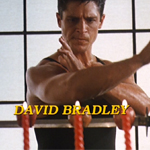 AMERICAN NINJA 5 is the explosive finale to the AMERICAN NINJA saga, by which I mean it’s an unrelated movie starring David Bradley that they retitled. At least that’s my assumption since he’s named Joe in this one instead of Sean. I could easily accept this character as Sean Davidson, who he played in parts 3 and 4, but they call him the other name so they must not have had that in mind while filming. He also opens the movie training with Tadashi “Bronson Lee” Yamashita, who played the Black Star Ninja in part 1, but this time Yamashita is credited as playing himself.
AMERICAN NINJA 5 is the explosive finale to the AMERICAN NINJA saga, by which I mean it’s an unrelated movie starring David Bradley that they retitled. At least that’s my assumption since he’s named Joe in this one instead of Sean. I could easily accept this character as Sean Davidson, who he played in parts 3 and 4, but they call him the other name so they must not have had that in mind while filming. He also opens the movie training with Tadashi “Bronson Lee” Yamashita, who played the Black Star Ninja in part 1, but this time Yamashita is credited as playing himself.
And I guess they must’ve decided that the title was misleading enough that they didn’t have to have a totally unrelated subtitle like all the other sequels. Something like AMERICAN NINJA 5: GAUNTLET OF FIRE or AMERICAN NINJA 5: IRON CLAW JUSTICE.
By the time this came out in 1993, ninjas were a subject of parody and kiddie fare. In the same year, the older brother of AMERICAN NINJA 5’s young star starred in SURF NINJAS with Rob Schneider and Leslie Nielsen. So this is a PG-13, sometimes jokey movie. Bradley has to take care of his master’s grand-nephew Hiro (introducing Lee Reyes). Also, his master, Master Tetsu, is played by Pat Morita, four years after THE KARATE KID III and the KARATE KID cartoon, one year before THE NEXT KARATE KID. Not very Cannonical. But it does have many elements of an AMERICAN NINJA movie: a scheming evil scientist, an army of multi-colored ninjas with one more visually distinguished lead ninja (with a snake-themed name, even), a kidnapping, sneaking into a foreign land, sneaking into a compound, getting jailed, doing a ninja hand signal meditation thing, child ninjitsu training montage, suppressed memories of childhood ninjitsu training.
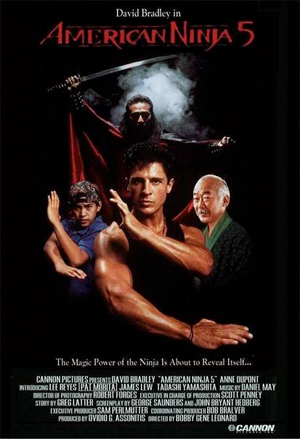 Initially Master Tetsu saddles Joe with surprise babysitting duties after he agreed to mere house sitting while the master is on a trip to Athens, but he never even makes it to the house. He’s forced to bring Hiro with him on a dinner date with Lisa (Anne Dupont), who he just met that day after she pretended to be a boat repair woman and messed up his small houseboat as an excuse to invite him over for an apology dinner (as women sometimes do). But during the date she goes into the kitchen to get dessert (or change into something more comfortable?) and gets drugged and abducted by some dudes. Joe and Hiro chase the dudes and stow away on their plane to Venezuela.
Initially Master Tetsu saddles Joe with surprise babysitting duties after he agreed to mere house sitting while the master is on a trip to Athens, but he never even makes it to the house. He’s forced to bring Hiro with him on a dinner date with Lisa (Anne Dupont), who he just met that day after she pretended to be a boat repair woman and messed up his small houseboat as an excuse to invite him over for an apology dinner (as women sometimes do). But during the date she goes into the kitchen to get dessert (or change into something more comfortable?) and gets drugged and abducted by some dudes. Joe and Hiro chase the dudes and stow away on their plane to Venezuela.
Lisa’s father (Aharon Ipale, the pharaoh in the MUMMY movies) is a scientist who invented a new insecticide that he’s being pressured into making into nerve gas, hence the kidnapping. The bad guy, Glock, is one of those older-guy-in-white-suit-hangs-out-at-swimming-pool-with-three-bikini-babes type of villains, but he doesn’t live up to the evil of the actor’s name, Clement von Franckenstein. He has a German Mechanic looking henchman named Flathead (Marc Fiorini, ANGELS & DEMONS) and his ninjas come in faded green or purple.
The lead ninja is named Viper (James Lew, BALANCE OF POWER). He leans heavily on the smoke bomb entrance and exit tricks, which I appreciate. He even does it just to show up for work.
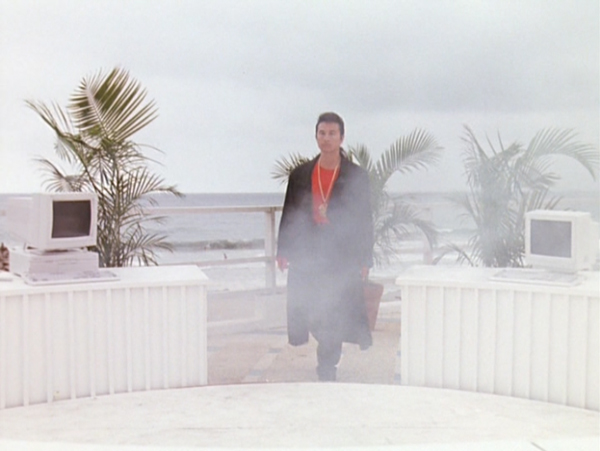
Glock yells “Get me Viper!” and boom, he’s there. Also his smoke bombs make cool laser type noises like an old Shaw Brothers movie. And most of the time he looks like he’s cosplaying the ’70s TV movie version of Dr. Strange.
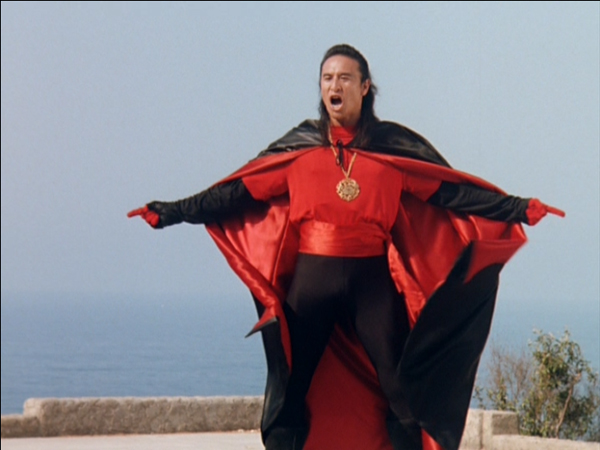
Hiro is the last of his ninja clan. His father was murdered. But for most of the movie he doesn’t know how to fight. He just plays his handheld Sega GameGear video game and eats things, including a bag of Doritos he finds on the ground – I couldn’t tell if it was awkward product placement, or just a sincere celebration of children’s love for Doritos brand tortilla chips. He also wears baggy jeans rolled up to display his Nikes and a Miami Dolphins windbreaker that seems to be intended for a large adult.
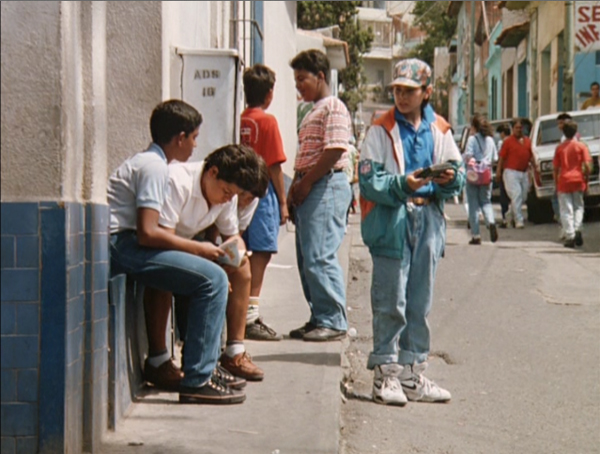
Like in xXx and at least 150 other movies, he has important skills (driving a car and flying a plane) that he’s able to just do on the first try because he plays video games.
Reyes (the younger brother of Ernie Reyes Jr., the biggest American martial arts child star ever) teeters on the line between annoying and endearing, flailing and mugging but also having a pretty natural little-kid type of humor when he jokes around with Joe. During the fights he does alot of delighted reaction shots like he’s constantly about to yell “AWESOME!” Then all the sudden he thinks Joe is dead and there’s a long scene of crying and then walking around whining and yelling because no one will tell him where the American Embassy is. Hats off to the shot that rotates around from him wandering the streets and reveals that Joe is nearby:
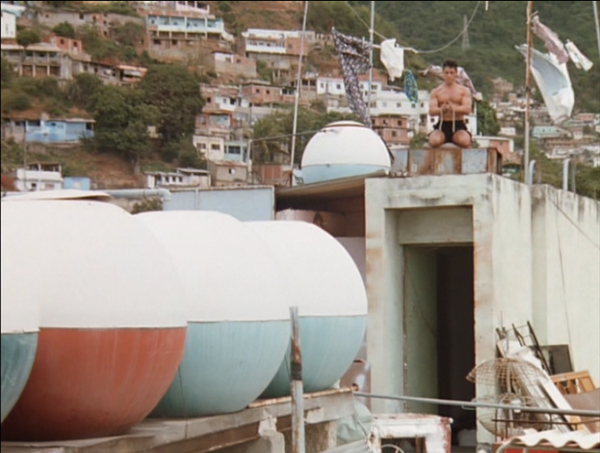
Once they’re reunited Hiro is right back to fearlessness, and he does a dumb joke where he pretends his video game is an uzi and mimes gunning down all the ninjas who are actually trying to murder him and his friend Joe.
Bradley is older, de-mulleted, and improved. He has a dry sense of humor and a slightly annoyed uncle rapport with the kid. With his experiences as an American Ninja he knows that when things get bad the best thing to do is sit on top of something tall and do that hand signal meditation thing. Later, when he agrees to train Hiro (right in the middle of this whole mess!?) they meditate together at a fire and Master Tetsu appears to them to offer wisdom. Hiro asks how he did it and Joe says that he’ll understand when he becomes a true ninja. I like to think this doesn’t mean that ninjas can mentally project themselves into other ninjas’ visions, but that it’s a ninja trick. Maybe when Tetsu was leaving on his trip at the beginning it was actually to Caracas to set up for this!
Near the end of the movie Hiro is finally reminded that “even before you could walk, you learned the ways of the shadow warrior” and takes part in the fights. In the tradition of part 2, Joe and Hiro steal ninja costumes and are able to walk around undetected at first.
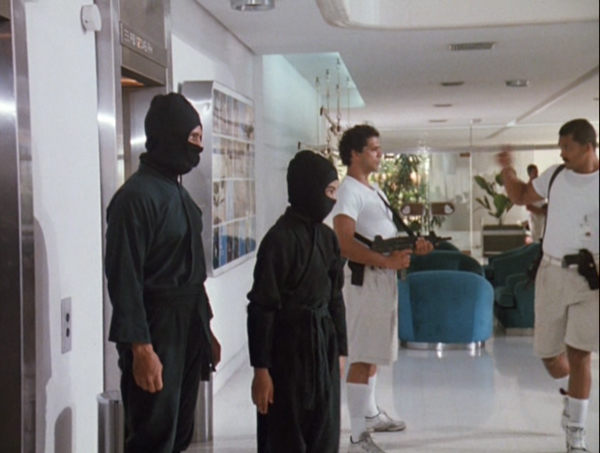
When they do have to fight Flathead finally notices that one of them is “a little ninja man.” I guess that was the title of the movie before it got promoted to an AMERICAN NINJA.
It’s an enjoyably dumb movie. There are many little touches to make it entertaining, including the weird detail that both the daughter and the kid say “That’s terrific!” when the doctor says that he successfully created an insecticide that doesn’t leave traces of toxins. They seem a little too enthusiastic about insecticide creation in my opinion. But it was the ’90s.
Part 5’s weakness as a part of the saga is a lower concentration of ninja shit. There’s a scene with a few attempted booby traps, and he uses a slingshot, and he rappels. But when he fights the ninjas they could be anyone fighting, there’s never a full on battle with arrows and swords and stuff like we’ve come to enjoy. Well, there’s a part where two white ninjas in a mostly white warehouse come at him with swords, and he jumps up and does the splits between two boxes and they cut each other. That was great. But we could use more of that.
Director Bob Bralver is still working as a stunt coordinator and director. He started as a stunt man on I Spy in the ’60s, moved into directing TV in the ’80s (Hardcastle and McCormick, Hunter, Knight Rider, Riptide, The A-Team) and this was his third feature film as a director. The one before this, MIDNIGHT RIDE (1990), actually starred Michael Dudikoff, along with Mark Hamill and Robert Mitchum. The story on this one is credited to Greg Latter (DELTA FORCE 3; actor in THE REDEMPTION: KICKBOXER 5), screenplay by George Sanders (MISSION OF JUSTICE, MARTIAL OUTLAW, SCANNER COP) & John Bryant Hedberg (only MISSION OF JUSTICE).
Reyes only did a couple other movies, but he did continue to fight.
* * *
The Antoine Doinel series shows the passage of time in many ways, most obviously through the aging of Jean-Pierre Leaud and other reoccurring actors from 1959-1979. We see Leaud as a new-to-acting little boy, then as a teenager, a young man, a middle-aged man. By the time the series finished he was a real actor with 53 credits to his name. Through the story we see him go from school to military to various jobs, from wannabe novelist to has-been. We see him go from too young for hookers to college crush to long term relationship, marriage, fatherhood, affair, divorce, new girlfriend, nostalgia for the college crush.
We also see Truffaut’s technique evolve from scrappy black and white to color, raw naturalism to occasional playful subjective gimmicks. We see hairstyles and clothes change. From the classroom of THE 400 BLOWS – at which point Charles Schulz had been drawing Peanuts for 9 years – we could never have dreamed of a world of Snoopy nightgowns.
The AMERICAN NINJA cycle captures time in different ways. It covers a period less than half as long, from 1985 to 1993, dictated not by the whims of an artist but by Golan and Globus’s perception of the commercial viability of the ninja trend they created. In part 1, the soldiers pass time playing hacky sack, a game that became popular in the U.S. in the early ’80s. In part 5 Hiro does it with a Sega Game Gear, the handheld video game system that was available from ’91 through ’97. When Joe asks him what he’s playing he says Moonwalker, the video game based on Michael Jackson’s 1988 film, which was available for some Sega systems, though not really the Game Gear.
LOVE ON THE RUN has its own references to cool music of the time. Check out this Tangerine Dream poster in the record store:
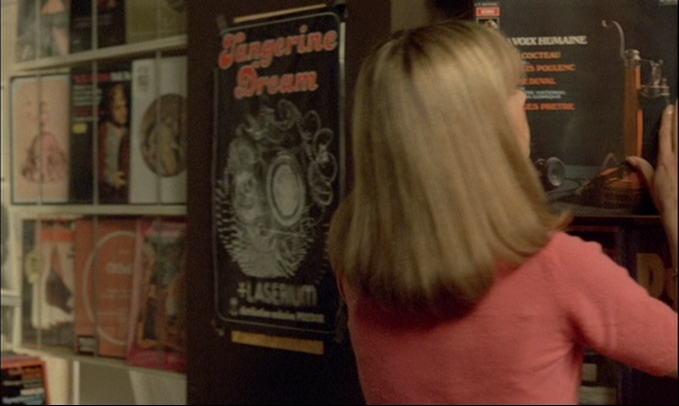
We do see Dudikoff and Bradley visibly age. We see Dudikoff’s execution of martial arts choreography improve and decline. We see Bradley get more comfortable with acting. We see him lose his mullet. Steve James does not age or change, though. Steve James is always Steve James. A constant, until he’s gone.
We see changes in low budget film production through the countries each installment films in. Part 1 (1985) filmed in the Philippines, known to exploitation filmmakers for its low price of filming since Roger Corman made his women’s prison movies there in the ’70s, and Cannon had already made ENTER THE NINJA and MISSING IN ACTION there. Part 2 (1987) and Part 3 (1989) filmed in South Africa, where Cannon had already filmed GOR, and could take advantage of tax breaks offered to attract filmmakers since many were scared off by the country’s oppressive race-based laws. Part 4 (1990) filmed partly in Johannesburg, according to IMDb, but partly in nearby Lesotho because Dudikoff would no longer work in the country of apartheid. Part 5 (1993) stayed out of that trouble and filmed in L.A., Rome and Venezuela (actually a pretty unusual place for exploitation filmmakers, though CANNIBAL HOLOCAUST had filmed there).
Both series are clearly made up as they go along, not sketched out from the beginning George Lucas style. They would make one movie at a time and cross the next bridge when they got to it. But the Antoines obviously ended up being the more consistent story, since the AMERICAN NINJAs don’t keep the same main character, or have any kind of continuity. Truffaut did a great job of progressing this character’s life and calling back organically to previous events when necessary.
It’s surprising, though, that the French New Wave one is the one that re-uses a bunch of old footage in their last installment, not the Cannon one. Congratulations on this victory, Cannon.
Of course these movies are opposites in type. Truffaut is telling intimate, even self-absorbed stories about his life, his relationships. The various Cannon directors rarely seem to be working from personal experience, they’re telling larger than life tales of a cartoonish version of another culture. But both of these entertain us by doing variations on the same thing five times. Whether it’s Antoine being kind of a selfish weirdo and screwing up different relationships in different ways (while failing at different jobs and having different awkward encounters with prostitutes) or one (or two) of the American Ninjas trying to rescue somebody and having to fight some scientist or business man and his army of multi-hewed super ninjas before and after his army of backup arrives, we have a loose idea of what we’re in for and that it will be easy to enjoy. I liked them in different ways.
I don’t think Antoine would’ve liked the AMERICAN NINJA series. If he ever learned of its existence he would’ve found it “very provincial.” Truffaut himself died just under a year before the first AMERICAN NINJA came out, so he never got a chance to try it out. And somehow I suspect he wouldn’t have taken the opportunity.
That’s his loss. Too often in life – especially in the niche-based culture created by the internet – we get stuck in a rut of only the things we think we want, the things we identify as our type of things. A sort of teenage mentality where we are categorized by the list of bands we like or whatever. In movie fandom I see many people dismiss my favorite types of movies as trash or camp or “so bad it’s good,” often based on hacky jokes they’ve heard and not actual familiarity with the movies. On the other hand, I see people (including some of us here) who like those but make their own assumptions about foreign or art films, quicker to call them “pretentious” than try to open themselves up to experience something different they might have to offer. And there’s a tendency to think the people who like or make those movies look down on us, and think that we’re not smart or don’t get it if we don’t like them. But maybe we should forgive all that take ol’ Sam-I-Am’s advice. Give it a taste.
I’m not sure I learned anything by doing this 10 movie comparison, other than confirm my suspicion that it is fun to do such a stupid, random, but potentially profound thing. And I think I chose my subject well because I got something out of all of these movies.
You don’t have to like everything, and I certainly don’t. But you can try to like anything. There are many good things in this world. Being able to appreciate a wide range of them makes life better.
<throws down smoke bomb>
This 11-part series took some extra loving time brought to you in part by my generous and heroic supporters on Patreon. If you like this sort of shit (with ninjas and art and what not) please consider joining them in supporting more important, soul-expanding movie scholarship.



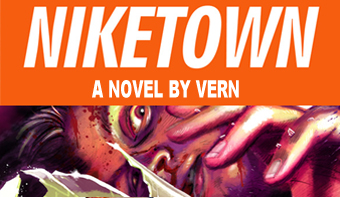
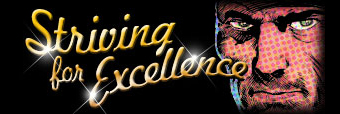
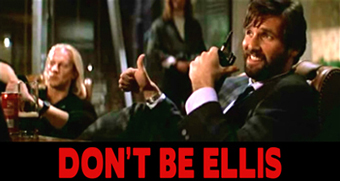

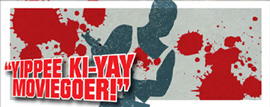








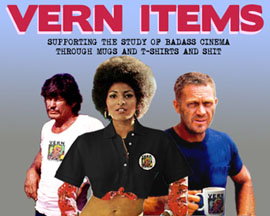
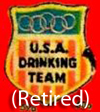








June 2nd, 2016 at 8:16 am
It was a good stylistic choice to fully visually show Hiro as down and out while wandering the streets with him getting stuck with a Game Gear instead of a Game Boy, his parents are dead and he’s got the inferior handheld. Since this isn’t what the Internet calls ‘grimdark’, he lucked out by not getting stuck with an Atari Lynx.